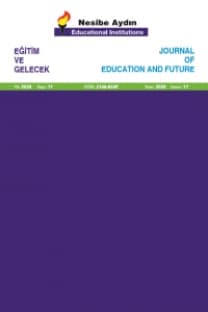A model of teaching reading and writing according to the constructed representational systems
Bu çalışmanın amacı; zihinsel engelli öğrencilere okumayazma öğretimsürecinde temsil sistemleri, NLP tekniklerinden çapalama tekniği ve hafızatekniklerinden foto grafik hafıza tekniğini kullanarak okuma-yazmayı daha kısasürede ve daha kolay öğretmektir. Farklı zamanlarda yapılan çalışmalardaokumayazma bilmeyen 12 öğrencinin performansı alınmış, alınanperformanslar ışığında 3 öğrenciye ba yöntemi, 9 öğrenciye de ses temellicümle yöntemi uygulanarak okumayazma öğretilmeye çalışılmıştır. Yapılançalışmalarda öğrencilere öğretilmek istenen her bir harf veya hece için, önceyalın bir görsel temsil gösterilmiş ve öğretilmek istenen harf veya heceninöğretimine önkoşul oluşturabilecek şekilde görsel temsil ile ilgilikonuşulmuştur. Gösterilen bu görsel temsil üzerinde bir değişiklik yapılarak,içinde öğretilmek istenen harfe veya heceye ait bir ipucu barındırır hale getirilenbu görsel temsil, bir de bu haliyle öğrenciye gösterilmiş ve tekrar öğretilmekistenen harf veya hecenin öğretimine önkoşul oluşturabilecek şekilde görseltemsil ile ilgili konuşulmuştur. Daha sonra harf veya hecenin sesletiminin nasılolduğu ve ağzımızdan nasıl çıktığı model olma yoluyla öğrenciye gösterilmiş veaynı harf veya heceyi öğrencinin de seslendirmesi istenmiştir. Daha sonraöğretilmesi planlanan harf veya hece için öğrencinin ilgi, istek, yetenek veyeterlilikleri göz önüne alınarak öğrenciye, bu harf veya hece için ipucu olmaniteliğinde bir dokunsal temsil (NLP çapalama tekniğinden esinlenlenerek)verilmiştir. Öğrenci gördüğü harf veya heceyi anımsayamaz ise, kendisineverilen dokunsal temsil sistemini kullanarak, bu dokunsal temsilin o harf veyaheceyi daha çabuk anımsamasını sağlamaktadır. Bu yöntemle 12 öğrenciden 8iokumayazmayı öğrenmiş, 4 öğrenci de öğrenme aşamasındadır. Okuma yazmayı bu yöntemle öğrenen ve hala öğrenmekte olan öğrencilerle, bu yöntemkullanılmadan önce okumayazma öğretilmeye çalışan öğrencilerinperformansı karşılaştırılmıştır. Akademik performans olarak birbirine yakınolan öğrenciler değerlendirildiğinde bu yöntem kullanılarak yapılan okuma yazma öğretim sürecinin diğer okumayazma öğretim süreçlerine göre dahakısa sür düğü ve öğrenciler in okuma- yazmayı bu yöntemle daha kolay öğrendiğisonucuna ulaşılmıştır.
Temsil sistemlerine göre yapılandırılmış okuma yazma öğretim modeli
The purpose of this study is to teach reading and writing to the studentswith mentally disabled in a short period and easier than nor mally have, usingNLP technique of anchor i ng and photographic memory techniques of memorytechniques. In studies which have made at different times, 12 illiterate studentshas performed and according to this performances 3 of this students were beganto teach readingwriting with technique of ba and 9 of remaining were beganto teach using the system of words based on sounds. In the studies, made by,for each letter and syllable demanding to teach to students, firstly a basicrepresentation was shown and it was spoken about the visual representationwhich will form pre condition concerning the syllable and letter, demanding totaught. After made some changes on this visual representation which wasshown, this visual representation was formed including t he clue about thesyllable or letter and after that it was shown to the student with its last form andit was spoken about its last form. Later , how was the pronunciation of thesyllable or letter and how gone out from mouth were tried to be taught to thestudents and they were requested to repeat. Afterwards, a tactual representation(inspired by NLP technique of anchoring) as a clue for syllable or letter wasgiven to the student considering to (his/her) student s interests, desires, abilities,qualifications. Normally the student can not remember the syllable or the letterwhich he/she has seen before, but if using the tactual representation, he/she willtry to recall it more quickly. With this method 8 /12 students began to read write, 4 students have been in teaching process. Each of the two performances,between the students that have taught with this way and still have been teaching,and also the students that have tried to be taught readingwriting before usetactual representation, were compared. If it is compared the students who aresimilar to each other academically, this method of education lasts shorter thanthe other methods and the students began to learn easier.
___
- Aruk, İ . (2008). Bilişim teknolojilerinin zihinsel engellilerin e- eğitiminde kullanilmasi ve örnek bir uygulama geliştirilmesi . (Unpublished masters thesis). Trakya University/Institute of Science, Edirne.
- Baran, Z. ( 2008) . NLP aslında beyin sizsiniz. İzmir : Bilgivizyon. Delen, F. ( 2013). Süper hafıza teknikleri. İstanbul: Zeka Evi.
- Kasaroğlu, Z. M., Şenyürek, B., Erduran, A,D. , & Yağbasan, R . ( 2008). Beyin yar ı kürelerinin baskın olarak kullanılmasina yönelik öğretim stratejileri . Gazi Eğitim Fakültesi Der gisi, 28 ( 2).
- Keleş, E., & Çepni, S. ( 2006). Beyin ve ö ğrenme. Türk Fen Eğitimi Dergisi, 3 (2).
- Kılınç M . ( 2005) . NLP ile etkin koçluk. İstanbul: Kariyer .
- Özak H. , & Avcıoğlu H. (2007). Zihinsel yetersizliği olan öğrencilere okuma becerilerinin öğretimi nde bilgisayar aracılığıyla sunulan eş zamanlı ipucuyla öğretimin etkililiği. Abant İzzet Baysal Üniversitesi Eğitim Fakültesi Dergisi, 12 (1).
- Korkmaz, Ö, & Mahiroğlu, A. ( 2007). Beyin, bellek ve öğrenme. Kastamonu Education Journal , 15 (1).
- Polat, M. ( 2014) . Beyin temelli öğrenmenin açılımı nedir ? Journal of Research in Education and Teaching, 3 (2).
- Saygın, O., Maraşlı, A. & Maraşlı, M., (2000). Hafıza teknikleriyle beyin gücünü geliştirme. İstanbul: Hayat.
- Yılma, G., Uçan B . (2014) . Eğitilebilir zihinsel engelli çocuklarda müzik aletlerinin görsel destekli algılanabilirliği üzerine bir çalışma. The Turkish Online Journal of Design, Art and Communication TOJDAC, 4 (1).
